Structure Formation in Engineered Wood Using Wood Waste and Biopolyurethane
Abstract
:1. Introduction
2. Materials and Methods
2.1. Raw Materials
2.2. Preparation of Wood Waste
2.3. Modification of Wood Waste
2.4. Preparation of Wood Waste-Based Engineered Wood Logs
2.5. Testing Methods
3. Results and Discussion
3.1. Parameters of Wood Waste
3.2. Strength Parameters of Engineered Wood
3.3. Structure of Wood Waste
3.4. Structure of Engineered Wood
4. Conclusions
- The chemical treatment of different wood wastes has different effects on the bulk density of the particles. The bulk density of chemically treated PLY particles decreased in all cases; the most significant decrease was 26.9%. In the case of DW, the bulk density increases under P and C treatments, i.e., the highest increase reaches 14.2%.
- The granulometric composition of different wood wastes differs. In DW particles, 40% to 60% consist of the small fraction varying from 0 to 1.25 mm, and in PLY particles, the large fraction varying from 2.5 to 10 mm prevails and constitutes 72.5–88.6%.
- The strength characteristics of wood waste-based engineered wood logs depend on the chemical treatment of the wood waste and the origin of the waste itself. The best effect is found when the W particles are treated with S. In this case, the compressive strength increases by 87%, and the tensile strength increases by 52.5%. According to the average values of both parameters, the obtained engineered wood with S-treated W particles can be assigned to T12 class based on the requirements of EN 338 [63] for sawn construction softwood.
- Analysis of the structure shows that the chemical treatment of wood waste removes small particles from the surface of larger particles and increases their surface roughness.
- Analysis of the structure of engineered wood samples shows that the use of untreated or improperly treated waste forms voids between the particles and does not create a reliable contact zone between the biopolyurethane binder and the wood waste particles.
- The results of these studies underscore the need for further research and development in the field of engineered wood production. It is clear that the method of chemical or other treatment should be selected for each type of wood waste separately. Special attention should be paid to the waste wood with binders used in primary products, which at the end of their life, became waste.
Author Contributions
Funding
Institutional Review Board Statement
Informed Consent Statement
Data Availability Statement
Conflicts of Interest
References
- Lima, M.D.R.; Ramalho, F.M.G.; Trugilho, P.F.; Bufalino, L.; Dias Júnior, A.F.; Protásio, T.P.; Hein, P.G.H. Classifying waste wood from Amazonian species by near-infrared spectroscopy (NIRS) to improve charcoal production. Renew. Energy 2022, 193, 584–594. [Google Scholar] [CrossRef]
- Liu, J.; Li, Y.; Mo, H.; Xie, E.; Fang, J.; Gan, W. Current utilization of waste biomass as filler for wood adhesives: A review. J. Ind. Eng. Chem. Res. 2022, 115, 48–61. [Google Scholar] [CrossRef]
- Nežerka, V.; Zbíral, T.; Trejbal, J. Machine-learning-assisted classification of construction and demolition waste fragments using computer vision: Convolution versus extraction of selected features. Expert. Syst. Appl. 2024, 238, 121568. [Google Scholar] [CrossRef]
- Lin, K.; Zhou, T.; Gao, X.; Li, Z.; Duan, H.; Wu, H.; Lu, G.; Zhao, Y. Deep convolutional neural networks for construction and demolition waste classification: VGGNet structures, cyclical learning rate, and knowledge transfer. J. Environ. Manag. 2022, 318, 115501. [Google Scholar] [CrossRef]
- Faraca, G.; Boldrin, A.; Astrup, T. Resource quality of wood waste: The importance of physical and chemical impurities in wood waste for recycling. Waste Manag. 2019, 87, 135–147. [Google Scholar] [CrossRef]
- Ismaeel, W.S.E.; Kassim, N. An environmental management plan for construction waste management. Ain Shams Eng. J. 2023, 14, 102244. [Google Scholar] [CrossRef]
- de Souza Pinho, G.C.; Calmon, J.L.; Medeiros, D.L.; Vieira, D.; Bravo, A. Wood Waste Management from the Furniture Industry: The Environmental Performances of Recycling, Energy Recovery, and Landfill Treatments. Sustainability 2023, 15, 14944. [Google Scholar] [CrossRef]
- Daian, G.; Ozarska, B. Wood waste management practices and strategies to increase sustainability standards in the Australian wooden furniture manufacturing sector. J. Clean. Prod. 2009, 17, 1594–1602. [Google Scholar] [CrossRef]
- Dinis, M.A.P. Composting of Wood Waste Materials Generated from the Furniture Industry in Portugal. In Minimizing the Environmental Impact of the Forest Products Industries; Jorge, F.C., Ed.; Fernando Pessoa University Editions: Porto, Portugal, 2011; pp. 77–81. [Google Scholar]
- Pandey, S. Wood waste utilization and associated product development from under-utilized low-quality wood and its prospects in Nepal. Appl. Sci. 2022, 4, 168. [Google Scholar] [CrossRef]
- Mancini, M.; Rinnan, Å. Classification of waste wood categories according to the best reuse using FT-NIR spectroscopy and chemometrics. Anal. Chim. Acta 2023, 1275, 341564. [Google Scholar] [CrossRef]
- Mancini, M.; Taavitsainen, V.M.; Rinnan, Å. Comparison of classification methods performance for defining the best reuse of waste wood material using NIR spectroscopy. Waste Manag. 2024, 178, 321–330. [Google Scholar] [CrossRef] [PubMed]
- Alakangas, E.; Koponen, K.; Sokka, L.; Keränen, J. Classification of used wood to biomass fuel or solid recycled fuel and cascading use in Finland. In Book of Proceeding Bioenergy, For Boost for Entire Bioenergy Business, 2—4.9.2015; Fair and Trade Center Paviljonki: Jyväskylä, Finland, 2015; pp. 79–86. [Google Scholar]
- Sarmin, S.N.; Jawaid, M.; Elias, R. (Eds.) Life Cycle Assessment of Wood Waste. In Wood Waste Management and Products; Springer: Berlin/Heidelberg, Germany, 2023; pp. 15–21. [Google Scholar] [CrossRef]
- Hasan, A.R.; Solo-Gabriele, H.; Townsend, T. Online sorting of recovered wood waste by automated XRF-technology: Part II. Sorting efficiencies. Waste Manag. 2011, 31, 695–704. [Google Scholar] [CrossRef] [PubMed]
- Besserer, A.; Troilo, S.; Girods, P.; Rogaume, Y.; Brosse, N. Cascading Recycling of Wood Waste: A Review. Polymers 2021, 13, 1752. [Google Scholar] [CrossRef] [PubMed]
- Uner, B.; Gökhan, K.; Yeşim, Y.; Yalçın, Ö.U.; Akgul, M. Wood Waste Turned Into Value Added Products: Thermal Plasticization by Benzylation Process. Drv. Ind. 2016, 67, 315–322. [Google Scholar] [CrossRef]
- Pelaez-Samaniego, M.R.; Yadama, V.; Lowell, E.; Espinoza-Herrera, R. A review of wood thermal pretreatments to improve wood composite properties. Wood Sci. Technol. 2013, 47, 1285–1319. [Google Scholar] [CrossRef]
- Nguyen, D.; Luedtke, J.; Nopens, M.; Krause, A. Production of wood-based panel from recycled wood resource: A literature review. Eur. J. Wood Prod. 2023, 81, 557–570. [Google Scholar] [CrossRef]
- Vitolina, S.; Shulga, G.; Neiberte, B.; Jaunslavietis, J.; Verovkins, A.; Betkers, T. Characteristics of the Waste Wood Biomass and Its Effect on the Properties of Wood Sanding Dust/Recycled PP Composite. Polymers 2022, 14, 468. [Google Scholar] [CrossRef] [PubMed]
- Berger, F.; Gauvin, F.; Brouwers, H.J.H. The recycling potential of wood waste into wood-wool/cement composite. Constr. Build. Mater. 2020, 260, 119786. [Google Scholar] [CrossRef]
- Edo-Alcón, N.; Gallardo, A.; Colomer-Mendoza, F.J.; Lobo, A. Efficiency of biological and mechanical-biological treatment plants for MSW. Case Spain 2024, 10, e26353. [Google Scholar] [CrossRef]
- Elsheikh, A.H.; Panchal, H.; Shanmugan, S.; Muthuramalingam, T.; El-Kassas, A.M.; Ramesh, B. Recent progresses in wood-plastic composites: Pre-processing treatments, manufacturing techniques, recyclability and eco-friendly assessment. Clean. Eng. Technol. 2022, 8, 100450. [Google Scholar] [CrossRef]
- Al-Kaseasbeh, Q.; Al-Qaralleh, M. Valorization of hydrophobic wood waste in concrete mixtures: Investigating the micro and macro relations. Results Eng. 2023, 17, 100877. [Google Scholar] [CrossRef]
- Lee, S.H.; Lum, W.C.; Boon, J.G.; Kristak, L.; Antov, P.; Pędzik, M.; Rogoziński, T.; Taghiyari, H.R.; Lubis, M.A.R.; Fatriasari, W.; et al. Particleboard from agricultural biomass and recycled wood waste: A review. J. Mater. Res. Technol. 2022, 20, 4630–4658. [Google Scholar] [CrossRef]
- Gibier, M.; Sadeghisadeghabad, M.; Girods, P.; Zoulalian, A.; Rogaume, Y. Furniture wood waste depollution through hydrolysis under pressurized water steam: Experimental work and kinetic modelization. J. Hazard. Mater. 2022, 436, 129126. [Google Scholar] [CrossRef]
- Chrobak, J.; Iłowska, J.; Chrobok, A. Formaldehyde-Free Resins for the Wood-Based Panel Industry: Alternatives to Formaldehyde and Novel Hardeners. Molecules 2022, 15, 4862. [Google Scholar] [CrossRef]
- Pocius, A.V. 8.12—Adhesives and Sealants. Polymer Science: A Comprehensive Reference; Matyjaszewski, K., Möller, M., Eds.; Elsevier: Amsterdam, The Netherlands, 2012; pp. 305–324. [Google Scholar] [CrossRef]
- Mathias, J.D.; Grédiac, M.; Michaud, P. 16—Bio-based adhesives. In Biopolymers and Biotech Admixtures for Eco-Efficient Construction Materials; Pacheco-Torgal, F., Ivanov, V., Karak, N., Jonkers, H., Eds.; Woodhead Publishing: Sawston, UK, 2016; pp. 369–385. [Google Scholar] [CrossRef]
- Liu, M.; Wang, Y.; Wu, Y.; He, Z.; Wan, H. “Greener” adhesives composed of urea-formaldehyde resin and cottonseed meal for wood-based composites. J. Clean. Prod. 2018, 187, 361–371. [Google Scholar] [CrossRef]
- Kawalerczyk, J.; Walkiewicz, J.; Sedliačik, J.; Dukarska, D.; Woźniak, M.; Mirski, R. Modified Buckwheat Husk as a Filler for Urea–Formaldehyde Resin in Plywood Production. Polymers 2024, 16, 1350. [Google Scholar] [CrossRef] [PubMed]
- Troilo, S.; Besserer, A.; Rose, C.; Saker, S.; Soufflet, L.; Brosse, N. Urea-Formaldehyde Resin Removal in Medium-Density Fiberboards by Steam Explosion: Developing Nondestructive Analytical Tools. ACS Sustain. Chem. Eng. 2023, 11, 3603–3610. [Google Scholar] [CrossRef]
- Savov, V.; Antov, P.; Panchev, C.; Lubis, M.A.R.; Taghiyari, H.R.; Lee, S.H.; Krišťák, Ľ.; Todorova, M. The Impact of Hydrolysis Regime on the Physical and Mechanical Characteristics of Medium-Density Fiberboards Manufactured from Recycled Wood Fibers. Fibers 2023, 11, 103. [Google Scholar] [CrossRef]
- Lubis, M.A.R.; Hidayat, W.; Zaini, L.H.; Park, B.D. Effects of Hydrolysis on the Removal of Cured Urea-Formaldehyde Adhesive in Waste Medium-Density Fiberboard. J. Sylva Lestari 2020, 8, 1–9. [Google Scholar] [CrossRef]
- Azambuja, R.R.; de Castro, V.G.; Trianoski, R.; Iwakiri, S. Recycling wood waste from construction and demolition to produce particleboards. Maderas, Cienc. Tecnol. 2018, 20, 681–690. [Google Scholar] [CrossRef]
- Christensen, J. Possibility to reuse and recycle wood waste and CDWW. In MSc in Resource Recovery Biotechnology and Bioeconomy; University of Boras: Boras, Sweden, 2023; 37p. [Google Scholar]
- Bourzik, O.; Akkouri, N.; Baba, K.; Nounah, A. Study of the effect of wood waste powder on the properties of concrete. Mater. Today Proc. 2022, 58, 1459–1463. [Google Scholar] [CrossRef]
- Demirbas, A. Reuse of Wood Wastes for Energy Generation. Energy Sources A Recovery Util. Environ. Eff. 2009, 31, 1687–1693. [Google Scholar] [CrossRef]
- Kharazipour, A.; Kües, U. Recycling of Wood Composites and Solid Wood Products. In Wood Production, Wood Technology, and Biotechnological Impacts, Chapter: Recycling of Wood Composites and Solid Wood Products; Kües, U., Ed.; Universitätsverlag Göttingen: Göttingen, Germany, 2007; pp. 509–533. [Google Scholar]
- Bayat, M. Types of Engineered Wood and Their Uses. In Current Applications of Engineered Wood; IntechOpen: London, UK, 2023; pp. 1–20. [Google Scholar]
- Smulski, S. Solid Wood Products. Structural Use of Wood. In Encyclopedia of Forest Sciences; Burley, J., Ed.; Elsevier: Amsterdam, The Netherlands, 2004; pp. 1318–1327. [Google Scholar] [CrossRef]
- Grebner, D.L.; Bettinger, P.; Siry, J.P.; Boston, K. Chapter 4—Forest products. In Introduction to Forestry and Natural Resources, 2nd, ed.; Grebner, D.L., Bettinger, P., Siry, J.P., Boston, K., Eds.; Academic Press: Cambridge, MA, USA, 2022; pp. 101–129. [Google Scholar] [CrossRef]
- Sandberg, D.; Gorbacheva, G.; Lichtenegger, H.; Niemz, P.; Teischinger, A. Advanced Engineered Wood-Material Concepts. In Springer Handbook of Wood Science and Technology; Niemz, P., Teischinger, A., Sandberg, D., Eds.; Springer Handbooks; Springer: Cham, Switzerland, 2023; pp. 1835–1888. [Google Scholar] [CrossRef]
- Bütün, F.Y.; Sauerbier, P.; Militz, H.; Mai, C. The effect of fibreboard (MDF) disintegration technique on wood polymer composites (WPC) produced with recovered wood particles. Compos. A Appl. Sci. Manuf. 2019, 118, 312–316. [Google Scholar] [CrossRef]
- Škulteckė, J.; Vaitkus, A.; Šernas, O. Laboratory investigation on the use of wood waste fibres in SMA mixtures. Constr. Build. Mater. 2023, 400, 132727. [Google Scholar] [CrossRef]
- Antwi-Boasiako, C.; Ofosuhene, L.; Boadu, K.B. Suitability of sawdust from three tropical timbers for wood-cement composites. J. Sustain. For. 2018, 37, 414–428. [Google Scholar] [CrossRef]
- Quiroga, A.; Marzocchi, V.; Rintoul, I. Influence of wood treatments on mechanical properties of wood–cement composites and of Populus Euroamericana wood fibers. Compos. B Eng. 2016, 84, 25–32. [Google Scholar] [CrossRef]
- Dias, S.; Almeida, J.; Santos, B.; Humbert, P.; Tadeu, A.; António, J.; de Brito, J.; Pinhão, P. Lightweight cement composites containing end-of-life treated wood—Leaching, hydration and mechanical tests. Constr. Build. Mater. 2022, 317, 125931. [Google Scholar] [CrossRef]
- Hung, K.-C.; Wu, T.-L.; Chen, Y.-L.; Wu, J.-H. Assessing the effect of wood acetylation on mechanical properties and extended creep behavior of wood/recycled-polypropylene composites. Constr. Build. Mater. 2016, 108, 139–145. [Google Scholar] [CrossRef]
- Olszewski, A.; Kosmela, P.; Piszczyk, L. A novel approach in wood waste utilization for manufacturing of catalyst-free polyurethane-wood composites (PU-WC). Sustain. Mater. Technol. 2023, 36, e00619. [Google Scholar] [CrossRef]
- Teacă, C.-A.; Shahzad, A.; Duceac, I.A.; Tanasă, F. The Re-/Up-Cycling of Wood Waste in Wood–Polymer Composites (WPCs) for Common Applications. Polymers 2023, 15, 3467. [Google Scholar] [CrossRef]
- Lopez, Y.M.; Paes, J.B.; Gustave, D.; Gonçalves, F.G.; Méndez, F.C.; Nantet, A.C.T. Production of wood-plastic composites using cedrela odorata sawdust waste and recycled thermoplastics mixture from post-consumer products—A sustainable approach for cleaner production in Cuba. J. Clean. Prod. 2020, 244, 118723. [Google Scholar] [CrossRef]
- Yang, H.; Tan, X.; Du, G.; Ni, K.; Wu, Y.; Li, Z.; Ran, X.; Gao, W.; Li, J.; Yang, L. Development of biomass adhesives based on aminated cellulose and oxidized sucrose reinforced with epoxy functionalized wood interface. Compos. B Eng. 2023, 263, 110872. [Google Scholar] [CrossRef]
- Zhu, Z.; Zhang, E.; Tu, Y.; Ye, M.; Chen, N. An Eco-Friendly Wood Adhesive Consisting of Soybean Protein and Cardanol-Based Epoxy for Wood Based Composites. Polymers 2022, 14, 2831. [Google Scholar] [CrossRef]
- Huang, J.; Li, K. A New Soy Flour-Based Adhesive for Making Interior Type II Plywood. J. Am. Oil Chem. Soc. 2008, 85, 63–70. [Google Scholar] [CrossRef]
- Mo, X.; Sun, X.S. Soy proteins as plywood adhesives: Formulation and characterization. J. Adhes. Sci. Technol. 2013, 27, 2014–2026. [Google Scholar] [CrossRef]
- Hussin, M.H.; Latif, N.H.A.; Hamidon, T.S.; Idris, N.N.; Hashim, R.; Appaturi, J.N.; Brosse, N.; Ziegler-Devin, I.; Chrusiel, L.; Fatriasari, W.; et al. Latest advancements in high-performance bio-based wood adhesives: A critical review. J. Mater. Res. Technol. 2022, 21, 3909–3946. [Google Scholar] [CrossRef]
- Papadopoulos, A.N. Advances in Wood Composites. Polymers 2020, 12, 48. [Google Scholar] [CrossRef]
- Savov, V.; Antov, P.; Zhou, Y.; Bekhta, P. Eco-Friendly Wood Composites: Design, Characterization and Applications. Polymers 2023, 15, 892. [Google Scholar] [CrossRef]
- Kaseem, M.; Hamad, K.; Deri, F.; Ko, Y.G. Material properties of polyethylene/wood composites: A review of recent works. Polym. Sci. Ser. A 2015, 57, 689–703. [Google Scholar] [CrossRef]
- Monteiro, S.; Martins, J.; Magalhães, F.D.; Carvalho, L. Lightweight Wood Composites: Challenges, Production and Performance. In Lignocellulosic Composite Materials 2018; Springer Series on Polymer and Composite Materials; Kalia, S., Ed.; Springer: Cham, Switzerland, 2018; pp. 293–322. [Google Scholar] [CrossRef]
- Niemz, P.; Sonderegger, W.; Gustafsson, P.J.; Kasal, B.; Polocoşer, T. Strength Properties of Wood and Wood-Based Materials. In Springer Handbook of Wood Science and Technology; Niemz, P., Teischinger, A., Sandberg, D., Eds.; Springer Handbooks; Springer: Cham, Switzerland, 2023. [Google Scholar] [CrossRef]
- EN 338; Structural Timber—Strength Classes. European Committee for Standardization: Brussels, Belgium, 2016.
- EN 1607; Thermal Insulating Products for Building Applications—Determination of Tensile Strength Perpendicular to Faces. European Committee for Standardization: Brussels, Belgium, 2013.
- EN ISO 29469; Thermal Insulating Products for Building Applications—Determination of Compression Behaviour. European Committee for Standardization: Brussels, Belgium, 2022.
- Kociszewski, M.; Gozdecki, C.; Wilczyński, A.; Zajchowski, S.; Mirowski, J. Effect of industrial wood particle size on mechanical properties of wood-polyvinyl chloride composites. Eur. J. Wood Prod. 2012, 70, 113–118. [Google Scholar] [CrossRef]
- Farrokhpayam, S.R.; Valadbeygi, T.; Sanei, E. Thin particleboard quality: Effect of particle size on the properties of the panel. J. Indian. Acad. Wood Sci. 2016, 13, 38–43. [Google Scholar] [CrossRef]
- Gozdecki, C.; Zajchowski, S.; Kociszewski, M.; Wilczyński, A.D.; Mirowski, J. Effect of wood particle size on mechanical properties of industrial wood particle-polyethylene composites. Polimery 2011, 56, 375–380. [Google Scholar] [CrossRef]
- Singh, M.K.; Arora, G.; Tewari, R.; Zafar, S.; Pathak, H.; Sehgal, A.K. Effect of pine cone filler particle size and treatment on the performance of recycled thermoplastics reinforced wood composites. Materials 2022, 62, 7358–7363. [Google Scholar] [CrossRef]
- Oduor, N.M.; Vinden, P. Dimensional Stability of Particle Board and Radiata Pine Wood (Pinus radiata D. Don) Treated with Different Resins. Int. J. Appl. Sci. Technol. 2013, 3, 153–159. [Google Scholar]
- Pouzet, M.; Dubois, M.; Charlet, K.; Béakou, A. From hydrophilic to hydrophobic wood using direct fluorination: A localized treatment. Comptes Rendus Chim. 2018, 21, 800–807. [Google Scholar] [CrossRef]
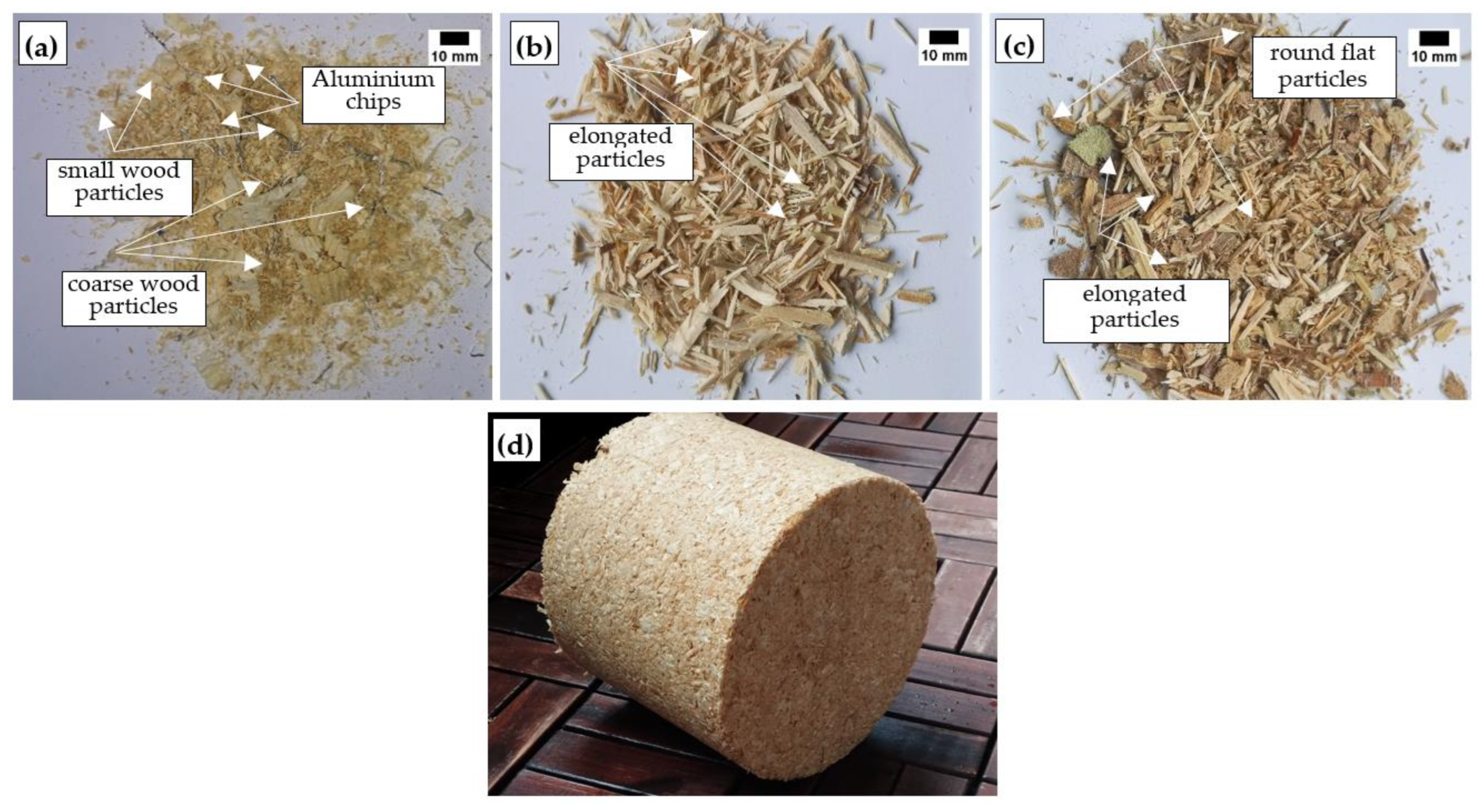

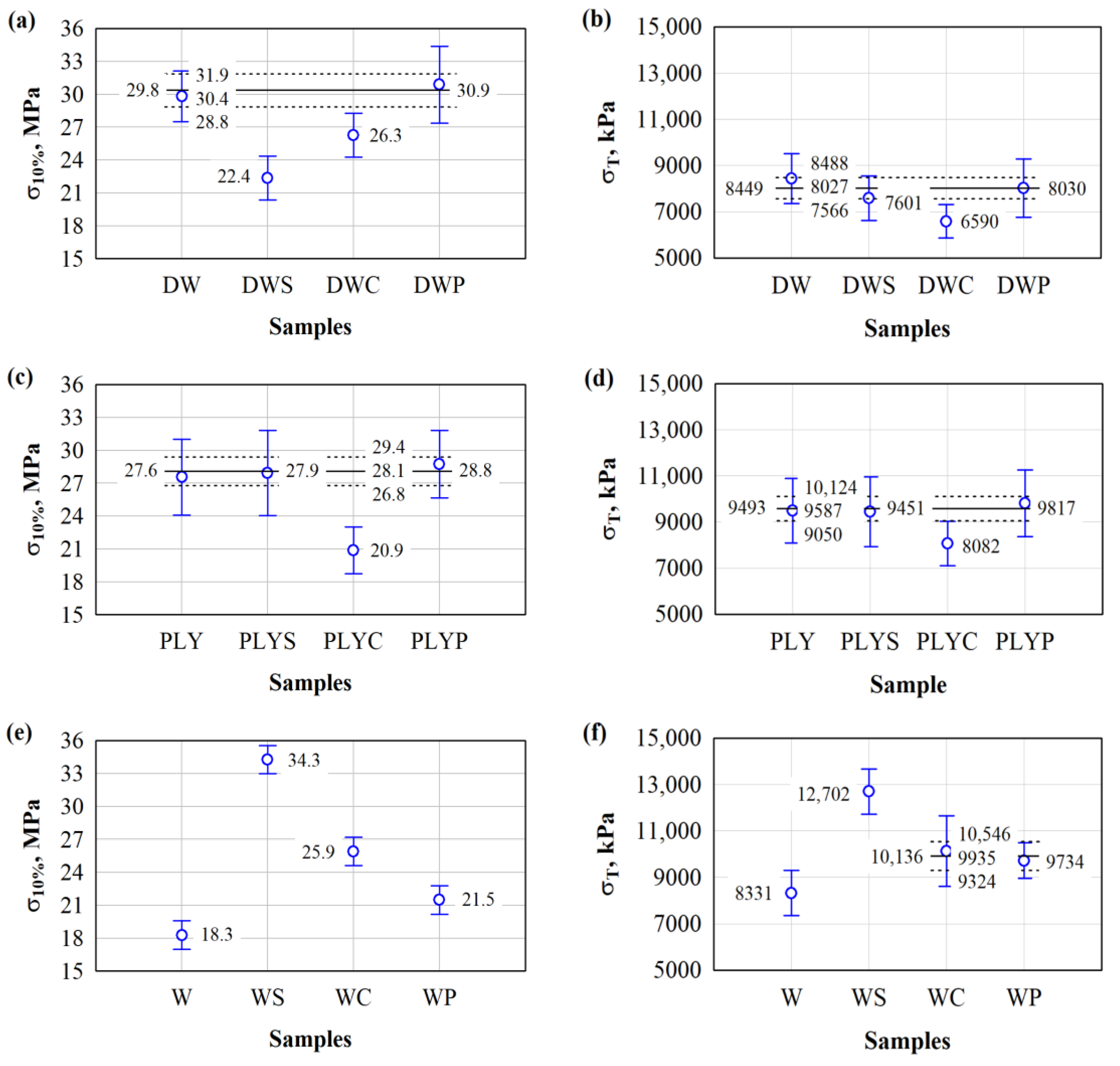

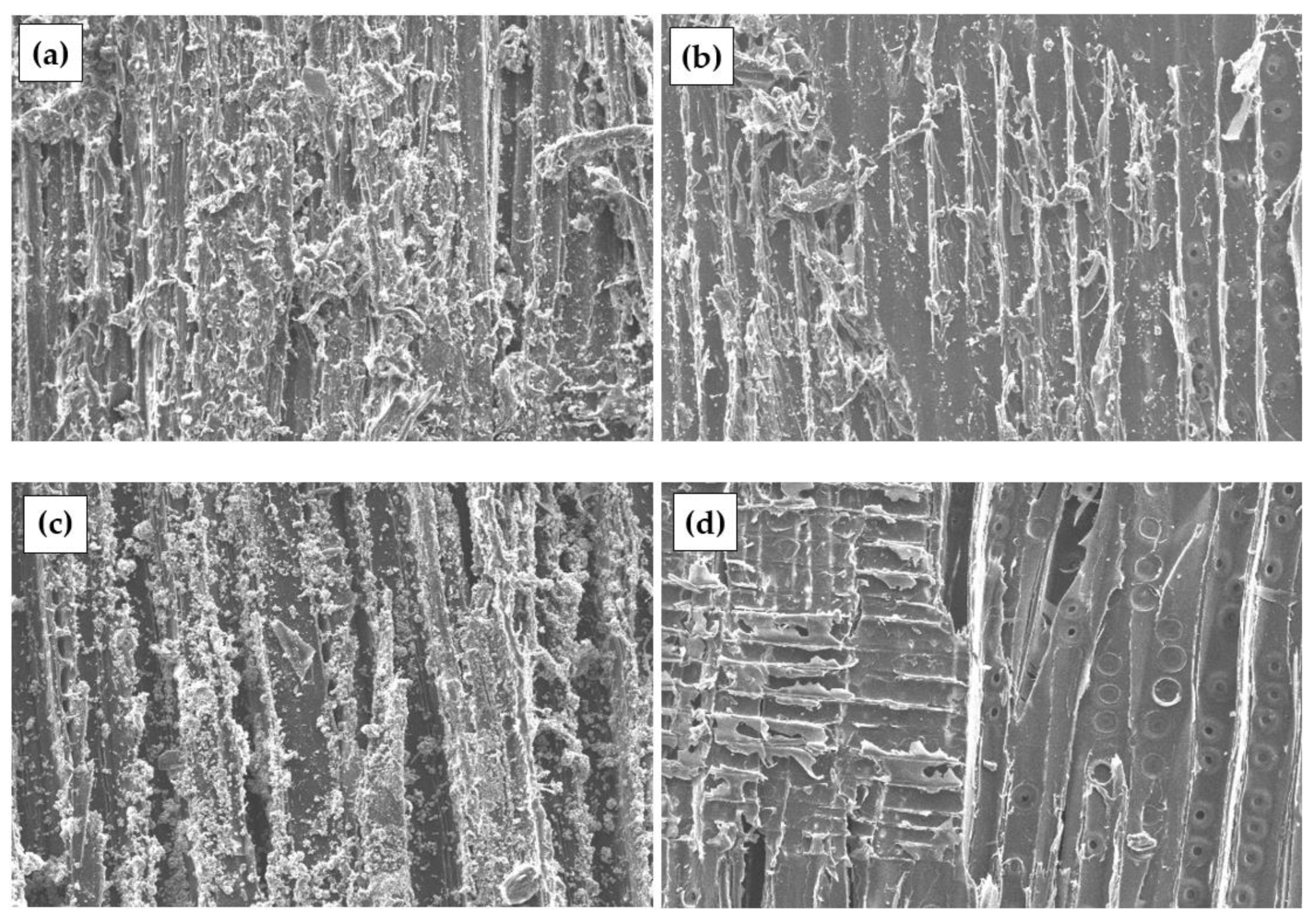
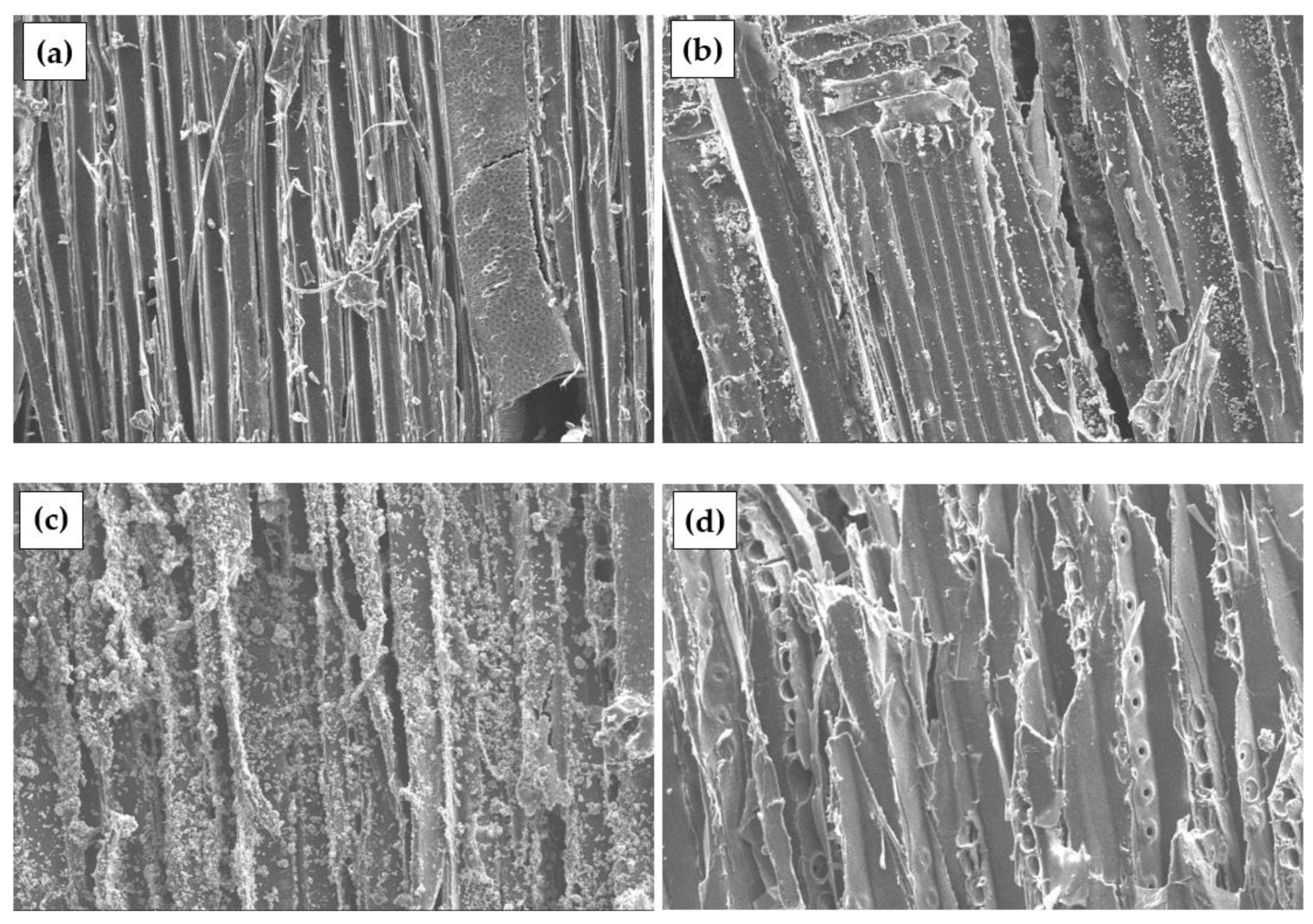
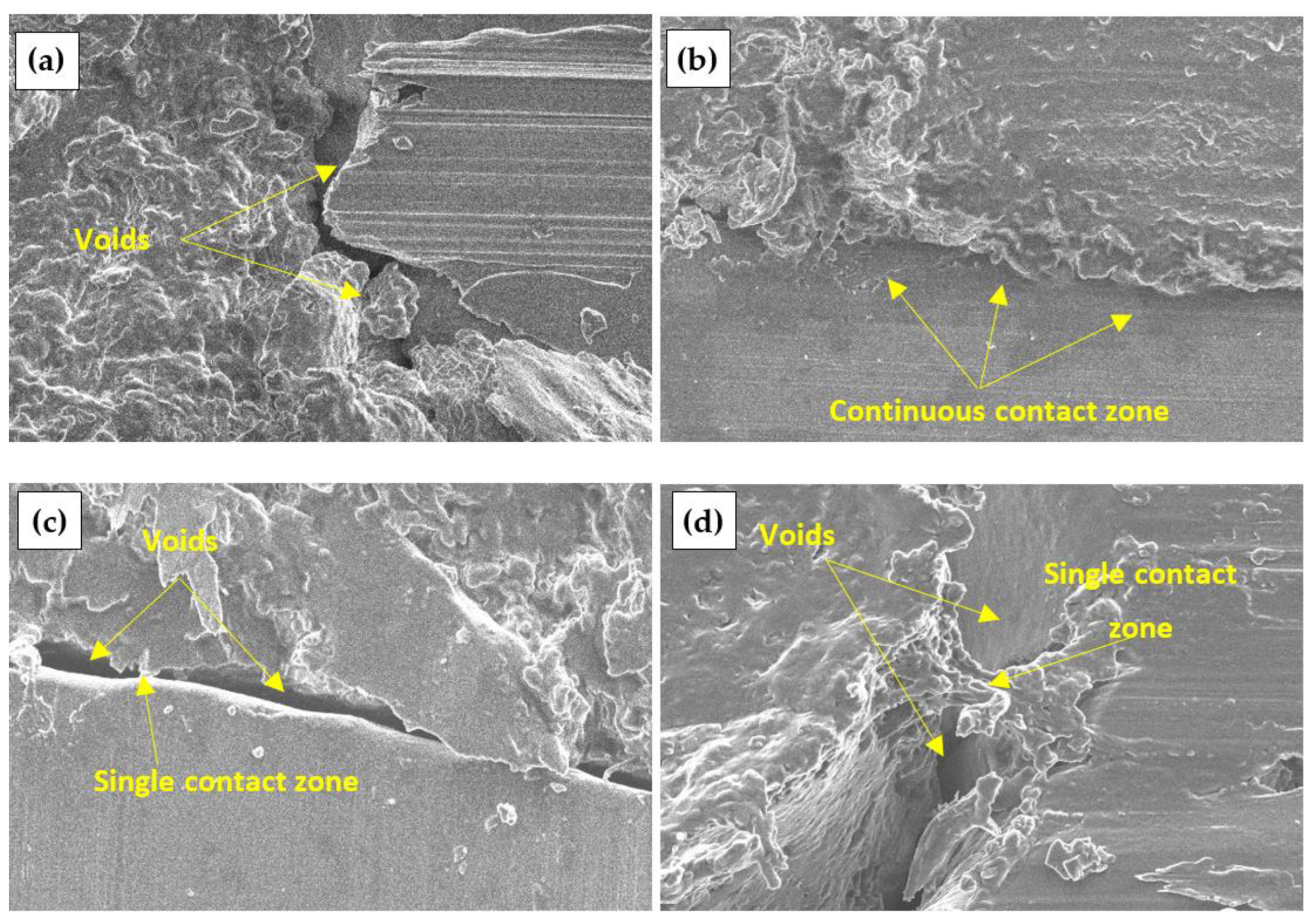
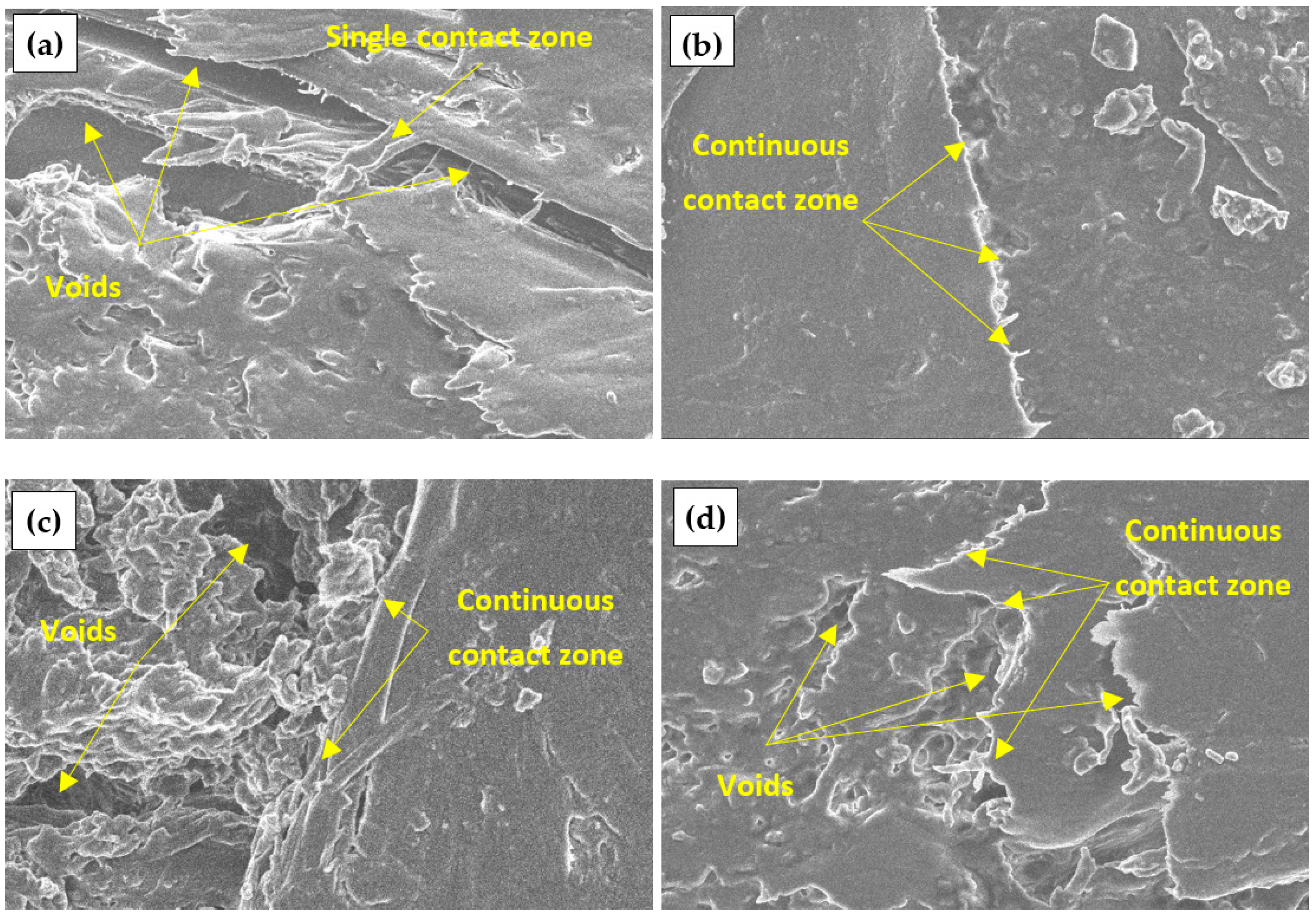

| Indicators | Residues on Different Sizes Sieves, wt.% | |||||
|---|---|---|---|---|---|---|
| 0–0.315 mm | >0.315–0.63 mm | >0.63–1.25 mm | >1.25–2.5 mm | >2.5–5 mm | >5 mm | |
| DW-Av./Std. | 1.18/0.063 | 13.01/0.085 | 26.73/0.095 | 3.89/0.120 | 41.96/0.090 | 13.23/0.450 |
| DWS-Av./Std. | 3.70/0.115 | 19.12/0.296 | 32.87/0.376 | 4.70/0.138 | 35.58/0.187 | 4.03/1.091 |
| DWC-Av./Std. | 3.36/0.072 | 21.01/0.114 | 36.97/0.241 | 3.36/0.118 | 33.61/0.151 | 1.69/0.691 |
| DWP-Av./Std. | 3.13/0.095 | 19.53/0.154 | 36.72/0.383 | 4.69/0.195 | 34.38/0.263 | 1.55/0.902 |
| PLY | 1.18/0.027 | 8.12/0.070 | 14.89/0.230 | 3.38/0.110 | 49.41/0.121 | 23.02/0.265 |
| PLYS | 1.35/0.085 | 8.78/0.075 | 14.19/0.100 | 2.70/0.0800 | 47.97/0.090 | 25.01/0.229 |
| PLYC | 1.33/0.082 | 7.33/0.066 | 11.33/0.106 | 2.00/0.118 | 46.67/0.336 | 31.34/0.125 |
| PLYP | 2.01/0.111 | 8.72/0.147 | 12.75/0.160 | 2.01/0.131 | 47.65/0.286 | 26.86/0.806 |
| W | 0.51/0.026 | 3.70/0.361 | 8.25/0.265 | 1.85/0.218 | 51.01/0.965 | 34.68/1.133 |
| WS | 0/0 | 2.68/0.131 | 7.37/0.150 | 1.34/0.053 | 49.95/0.145 | 38.66/0.287 |
| WC | 0/0 | 3.33/0.046 | 8/0.167 | 1.33/0.050 | 55.33/0.669 | 32.01/0.469 |
| WP | 0.67/0.104 | 4.70/0.190 | 8.72/0.121 | 1.34/0.072 | 51.01/1.012 | 33.56/1.005 |
Disclaimer/Publisher’s Note: The statements, opinions and data contained in all publications are solely those of the individual author(s) and contributor(s) and not of MDPI and/or the editor(s). MDPI and/or the editor(s) disclaim responsibility for any injury to people or property resulting from any ideas, methods, instructions or products referred to in the content. |
© 2024 by the authors. Licensee MDPI, Basel, Switzerland. This article is an open access article distributed under the terms and conditions of the Creative Commons Attribution (CC BY) license (https://creativecommons.org/licenses/by/4.0/).
Share and Cite
Rimkienė, A.; Kairytė, A.; Vėjelis, S.; Kremensas, A.; Vaitkus, S.; Šeputytė-Jucikė, J. Structure Formation in Engineered Wood Using Wood Waste and Biopolyurethane. Materials 2024, 17, 4087. https://doi.org/10.3390/ma17164087
Rimkienė A, Kairytė A, Vėjelis S, Kremensas A, Vaitkus S, Šeputytė-Jucikė J. Structure Formation in Engineered Wood Using Wood Waste and Biopolyurethane. Materials. 2024; 17(16):4087. https://doi.org/10.3390/ma17164087
Chicago/Turabian StyleRimkienė, Aurelija, Agnė Kairytė, Sigitas Vėjelis, Arūnas Kremensas, Saulius Vaitkus, and Jurga Šeputytė-Jucikė. 2024. "Structure Formation in Engineered Wood Using Wood Waste and Biopolyurethane" Materials 17, no. 16: 4087. https://doi.org/10.3390/ma17164087






